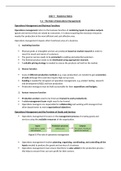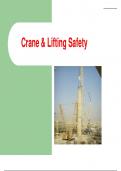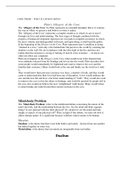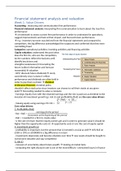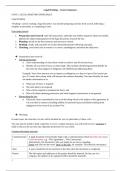Unit 5 – Business Notes
5.1 - The Role of Operations Management
Operations Management and Business Functions
Operations management refers to the business function of combining inputs to produce outputs
(goods and services) that are valued by consumers. It is about acquiring the necessary resources
needed for production in the most efficient and cost-effective way.
Operations management impacts other functional areas of a business:
1. marketing function
Physical goods or intangible services are produced based on market research in order to
meet the needs and wants of customers.
The good or service needs to be promoted to existing and potential customers.
The finished product needs to be distributed using appropriate channels.
A suitable pricing strategy is needed to ensure the products sell well on the market.
2. finance function
Costs of different production methods (e.g. mass production) are needed to gain economies
of scale although this could also require high set-up costs.
Funding is needed for all aspects of operation management, e.g. product testing, research
and development (R&D) and lean production.
Production managers must be held accountable for their expenditure and budgets.
3. human resources function
Production workers need to be hired and trained to work productively.
A crisis management team might need to be formed.
Operations managers are responsible for collaborating and working with managers from
other departments to meet organizational objectives.
Operations Management and the Provision of Goods and Services
Operations management focuses on the management process of creating goods and
services using the available resources of the organization.
Operations management involves planning, organizing, coordinating, and controlling all the
inputs needed to produce the goods and services of a business.
Operations management must ensure that there is value added in the production process –
this helps to ensure firms can earn profit for their owners.
,Operations Management Strategies and Practices
Business operations have an important role in ensuring sustainability by creating a balance between
the ecological, social and economic needs of current and future generations. Businesses are
increasingly reporting their triple bottom line to evaluate their performance in a broader context of
sustainable business activity. This comprises of environmental sustainability, economic
sustainability, and social sustainability.
Sustainability is a concept which promotes intergenerational equity, i.e. business activity is able to
meet the needs of the current generation without jeopardizing the needs of future generations.
Elkington’s pillars of sustainability are sometimes also referred to as the 3 Ps of sustainability:
people, planet and profit.
1. ecological sustainability – refers to the capacity of the natural environment to meet the
needs of the current generation without risking the needs of future generations.
A lack of ecological sustainability means that production will deplete the earth’s natural
resources for future generations, e.g. overfishing or deforestation.
It requires efficient and sensible use of the planet’s scarce resources so that they do not
become exhausted.
The exponential population growth of the world’s population puts huge pressures on the
planet’s finite resources – makes ecological sustainability a key priority.
Examples of ecologically sustainable business practices include:
Green technologies – environmentally friendly innovations, e.g. renewable energy.
Recycling – turning waste products into reusable materials.
Ecological footprint – the impact of resource consumption and waste production on the
natural environment, e.g. using online tech for meetings instead of driving to locations.
Conservation – using renewable resources at a sustainable rate, e.g. trees or fish.
Preservation – reducing the human impact on the environment
2. social sustainability – examines the ability of businesses and people to develop in such a
way that they can meet the social well-being needs of current and future generations.
Social sustainability enables society to optimize the quality of life for current and future
generations – on the other hand, social hurdles prevent a community from developing, e.g.
poverty, unemployment and social exclusion (racism and gender inequality).
Elkington argued that male business leaders need to accept women as equals if there is to
be social sustainability and development – embracing social justice can bring about many
opportunities in terms of recruitment, staff retention and corporate reputation.
Gender discrimination represents an inefficient allocation of human resources.
In addition to creating jobs and paying taxes, many countries expect businesses to fulfill their
CSR – ignoring CSR can attract unwanted media attention.
3. economic sustainability – refers to development of a country that meet the economic needs
of the current and future generation using its existing available resources.
, Economic sustainability requires businesses to use their resources (land, labour, capital and
enterprise) efficiently and in a maintainable way - increased global demand and
consumption make it more difficult to sustain the output of products over time.
The overuse of scare resources is a major threat to a country’s economic well-being, e.g. a
rapid economic development in some countries has led to the rapid depletion of the world’s
finite resources, especially non-renewable resources.
However, in their endeavor to maximize profits for shareholders and due to the potentially
higher costs of operating in a sustainable way, not many businesses make efficient use of
available resources.
Economic sustainability as a business strategy can help firms to survive, thrive, and
contribute to the economic well-being of others via the creation of jobs and wealth.
5.2 – Production Methods
Job Production
Production refers to the manufacture or output of a physical good or intangible service. There are 4
main production methods: job, batch, mass and cellular.
Job production is the production of a special or customized good or service suited to the specific
requirements of an individual customer.
Each order is a one-off, unique good or service – it is the most labour intensive method of
production as its reliant on skilled workers.
It is also the most expensive production method, although clients pay relatively high prices
for the uniqueness of the product – examples include movies, cakes, artwork etc.
Advantages of Job Production Disadvantages of Job Production
most flexible method of production as orders high labour costs due to the need of highly
are made as per the customer skilled and experienced workers
output is likely to be of outstanding quality high production costs (no economies of scale)
high mark-up price can be charged because of production is time consuming because specific
the exclusivity and high quality requirements need to be catered for
Batch Production
Batch production is a production method that involves identical goods being made in groups
(batches) rather than in a continuous flow.
Goods are produced in consignments (batches), undergoing the production process at the
same time, before manufacturing the next batch with different specifications.
It does not involve a system of continuous production.
Workers are likely to be semi-skilled and output is far more capital intensive than job
production – examples include cookies, bread, shoes, clothes etc.
Advantages of Batch Production Disadvantages of Batch Production
average costs of production are lower than job less flexibility as customers have to select from
production – possible economies of scale a range of standardized output
some flexibility to meet a variety of demands greater need for stock (inventories)
useful for small businesses that can’t afford there is ‘downtime’ between batches as
continuous production lines machinery might need changing
Mass and Flow Production
5.1 - The Role of Operations Management
Operations Management and Business Functions
Operations management refers to the business function of combining inputs to produce outputs
(goods and services) that are valued by consumers. It is about acquiring the necessary resources
needed for production in the most efficient and cost-effective way.
Operations management impacts other functional areas of a business:
1. marketing function
Physical goods or intangible services are produced based on market research in order to
meet the needs and wants of customers.
The good or service needs to be promoted to existing and potential customers.
The finished product needs to be distributed using appropriate channels.
A suitable pricing strategy is needed to ensure the products sell well on the market.
2. finance function
Costs of different production methods (e.g. mass production) are needed to gain economies
of scale although this could also require high set-up costs.
Funding is needed for all aspects of operation management, e.g. product testing, research
and development (R&D) and lean production.
Production managers must be held accountable for their expenditure and budgets.
3. human resources function
Production workers need to be hired and trained to work productively.
A crisis management team might need to be formed.
Operations managers are responsible for collaborating and working with managers from
other departments to meet organizational objectives.
Operations Management and the Provision of Goods and Services
Operations management focuses on the management process of creating goods and
services using the available resources of the organization.
Operations management involves planning, organizing, coordinating, and controlling all the
inputs needed to produce the goods and services of a business.
Operations management must ensure that there is value added in the production process –
this helps to ensure firms can earn profit for their owners.
,Operations Management Strategies and Practices
Business operations have an important role in ensuring sustainability by creating a balance between
the ecological, social and economic needs of current and future generations. Businesses are
increasingly reporting their triple bottom line to evaluate their performance in a broader context of
sustainable business activity. This comprises of environmental sustainability, economic
sustainability, and social sustainability.
Sustainability is a concept which promotes intergenerational equity, i.e. business activity is able to
meet the needs of the current generation without jeopardizing the needs of future generations.
Elkington’s pillars of sustainability are sometimes also referred to as the 3 Ps of sustainability:
people, planet and profit.
1. ecological sustainability – refers to the capacity of the natural environment to meet the
needs of the current generation without risking the needs of future generations.
A lack of ecological sustainability means that production will deplete the earth’s natural
resources for future generations, e.g. overfishing or deforestation.
It requires efficient and sensible use of the planet’s scarce resources so that they do not
become exhausted.
The exponential population growth of the world’s population puts huge pressures on the
planet’s finite resources – makes ecological sustainability a key priority.
Examples of ecologically sustainable business practices include:
Green technologies – environmentally friendly innovations, e.g. renewable energy.
Recycling – turning waste products into reusable materials.
Ecological footprint – the impact of resource consumption and waste production on the
natural environment, e.g. using online tech for meetings instead of driving to locations.
Conservation – using renewable resources at a sustainable rate, e.g. trees or fish.
Preservation – reducing the human impact on the environment
2. social sustainability – examines the ability of businesses and people to develop in such a
way that they can meet the social well-being needs of current and future generations.
Social sustainability enables society to optimize the quality of life for current and future
generations – on the other hand, social hurdles prevent a community from developing, e.g.
poverty, unemployment and social exclusion (racism and gender inequality).
Elkington argued that male business leaders need to accept women as equals if there is to
be social sustainability and development – embracing social justice can bring about many
opportunities in terms of recruitment, staff retention and corporate reputation.
Gender discrimination represents an inefficient allocation of human resources.
In addition to creating jobs and paying taxes, many countries expect businesses to fulfill their
CSR – ignoring CSR can attract unwanted media attention.
3. economic sustainability – refers to development of a country that meet the economic needs
of the current and future generation using its existing available resources.
, Economic sustainability requires businesses to use their resources (land, labour, capital and
enterprise) efficiently and in a maintainable way - increased global demand and
consumption make it more difficult to sustain the output of products over time.
The overuse of scare resources is a major threat to a country’s economic well-being, e.g. a
rapid economic development in some countries has led to the rapid depletion of the world’s
finite resources, especially non-renewable resources.
However, in their endeavor to maximize profits for shareholders and due to the potentially
higher costs of operating in a sustainable way, not many businesses make efficient use of
available resources.
Economic sustainability as a business strategy can help firms to survive, thrive, and
contribute to the economic well-being of others via the creation of jobs and wealth.
5.2 – Production Methods
Job Production
Production refers to the manufacture or output of a physical good or intangible service. There are 4
main production methods: job, batch, mass and cellular.
Job production is the production of a special or customized good or service suited to the specific
requirements of an individual customer.
Each order is a one-off, unique good or service – it is the most labour intensive method of
production as its reliant on skilled workers.
It is also the most expensive production method, although clients pay relatively high prices
for the uniqueness of the product – examples include movies, cakes, artwork etc.
Advantages of Job Production Disadvantages of Job Production
most flexible method of production as orders high labour costs due to the need of highly
are made as per the customer skilled and experienced workers
output is likely to be of outstanding quality high production costs (no economies of scale)
high mark-up price can be charged because of production is time consuming because specific
the exclusivity and high quality requirements need to be catered for
Batch Production
Batch production is a production method that involves identical goods being made in groups
(batches) rather than in a continuous flow.
Goods are produced in consignments (batches), undergoing the production process at the
same time, before manufacturing the next batch with different specifications.
It does not involve a system of continuous production.
Workers are likely to be semi-skilled and output is far more capital intensive than job
production – examples include cookies, bread, shoes, clothes etc.
Advantages of Batch Production Disadvantages of Batch Production
average costs of production are lower than job less flexibility as customers have to select from
production – possible economies of scale a range of standardized output
some flexibility to meet a variety of demands greater need for stock (inventories)
useful for small businesses that can’t afford there is ‘downtime’ between batches as
continuous production lines machinery might need changing
Mass and Flow Production


